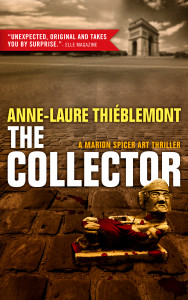by Anne-Laure Thiéblemont, @LeFrenchBook
I just wanted to write. How I dreamed of that when I had nothing but a day job. Yet, if I hadn’t had that job, how could I give my stories the same realism? What I do know is that writing means I lead a double life. It’s a job, it’s a craft, it demands do it regularly and alone. Here are some tips I have picked up from my life as both a reporter and a fiction writer.
– There is no writing without passion. If your drive comes from anywhere else—wanting to make a living or be recognized and admired—you had best do something else.
– Find the time—take it from your sleep, your vacation, your time with others, your family life. I recommend at least three hours a day.
– Writing is also reading, particularly at the beginning when you still have all the techniques to learn.
– Read to understand how dialogue works.
– Read to understand how protagonists evolve, experiencing some for of transformation or even initiation.
– Read to understand how stories are cut into chapters.
– Read some more to understand that everything has a meaning and nothing is innocent—a description of landscape or a décor is only interesting if it plays a role in the story and interacts with the characters.
– It is not writing that counts the most, but building.
– Take your time. Let the text sit for a week or a month or more. Get some distance from it and even start over again.
– Never get discouraged. Perseverance is part of a writer’s DNA.
An art reporter and trained gem specialist based in Marseille, France, Anne-Laure  Thiéblemont is known for her investigations into stolen art and gem trafficking. Her art world mystery novel, The Collector, just came out in English, published by Le French Book.
Thiéblemont is known for her investigations into stolen art and gem trafficking. Her art world mystery novel, The Collector, just came out in English, published by Le French Book.
The Collector:
Some people collect art, others collect trouble. Marion Spicer spends her days examining auction catalogues and searching for stolen works of art. She is a top-notch investigator when it comes to eighteenth-century art. But for her it’s just a job and her life is well ordered. All this changes when she inherits a prestigious collection of pre-Columbian art from a father she never knew. There are conditions attached: she must first find three priceless statues. Her father’s death sparked much greed, and Marion finds herself facing the merciless microcosm of Paris art auctions and galleries, with its sharks, schemes, fences, traps, scams, and attacks. Her quest draws her into a world where people will kill for a love of beauty.
Description is only interesting if it plays a role? Awesome. Knew there was a reason I don’t write a lot of description.
Alex–Me too! As I reader, I skim description unless it’s really vital to the story. As a writer, I force myself to include it.
One role of description is establishing the writer’s voice. And a skilled writer makes it work twice as hard, such as when Chandler has Philip Marlowe say that the Sternwood mansion didn’t have as many windows as the Chrysler building. We hear Chandler’s voice clearly and learn about the Sternwoods at the same time.
Elizabeth – Thanks for hosting Anne-Laure.
Anne-Laure – Thanks for sharing your advice. Writing and reading really do go together integrally, so I’m glad you discuss the way reading supports writing. Wishing you much success.
“–a description of landscape or a décor is only interesting if it plays a role in the story and interacts with the characters.”
Must print this out and tape it to my head. I tend to write too much description and end up tossing out tens of thousands of words.
Thanks, Anne-Laure.
Love all these nuggets of wisdom. Thank you!
Oh, I think your day job sounds fascinating! You’d make a good main character! Thanks for the tips!
This is advice that suits my thoughts! Thanks for sharing.
Hi Elizabeth and Anne-Laure – we also need to know about things … I was reading about poplars surrounding a square in – and I could relate to two lines of poplars we had near my childhood home and then those portrayed by artists in the medieval world of Italy … gives a picture to the writing … and I can relate. Description can keep us within the story and enhances its telling …
Cheers and great advice .. as well as perseverance .. Hilary